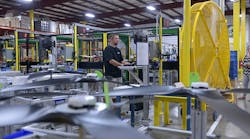The term “reshoring” — bringing manufacturing jobs back to America from overseas — has received a lot of attention in the past couple of years. With the rise of labor costs in China and elsewhere, American wages have become more competitive, making it possible for more companies to at least consider manufacturing their products in America. At Big Ass Fans, we go to great lengths to make our fans here, because we’re patriotic, of course, but more so because we’re control freaks, and having production nearby is the best way to control what gets shipped with our name on it.
We employ more than 125 people on our production lines in Kentucky, where we are headquartered, and have plans to add more than 15 this year as our Haiku Home residential division expands. We have a factory in Malaysia, because that’s where the chief designer whose company we acquired makes his home. It’s our factory in Malaysia and our employees. But in the past few years we’ve shifted from originally using an all-Asian supply chain for residential products to the vast majority of our residential fan lines being manufactured here in Lexington.
A host of factors, including cost, were weighed in the decision to move work here. But ultimately it came down to proximity, proximity, proximity — a twist on the familiar real-estate mantra. That means proximity to our production lines, to our suppliers and most importantly, to our customers. For us, being close to all three is essential if we are to maintain quality control and customer focus, our top company priorities.
We all know the reason manufacturing jobs went overseas in the first place is because of labor costs, and obviously that’s always going to be an important consideration for any business. At Big Ass Fans, we consider cost, but it’s never our main consideration. If it was, we wouldn’t pay our employees 20% more than the national average and 40% more than our state’s average — which we do, happily, because our focus on quality extends to our employees, too.
If your only consideration is cost, you’re always going to manufacture your products someplace other than America. Today it might be China, tomorrow Hungary or Vietnam.... But your business will pay a hefty price because you’ll never have the same level of oversight or flexibility — and your suppliers will resent the hell out of you.
—Carey Smith
We’ve had different challenges here than overseas, and it hasn’t been a clear path either way, but from a quality standpoint, local manufacturing works best because most of our main suppliers are within a day’s drive. We can get the quality team in the car and go take a look at the plant — whether it’s gearboxes up the road in Maysville, Ky., or metal frames from nearby Hebron. We can be there on short notice for face-to-face meetings. Being in the same room allows us to build and maintain the kind of good relationships that are so crucial with vendors.
Some components, unfortunately, we have no choice but to source overseas. When we started out, we could buy variable frequency drives for our big fans that were made in America. Now they’re all made overseas. That’s just the way it is.
There are so many other factors to consider — inventory carrying costs, logistics costs, transit time. Our model mix — we have tens of thousands of SKUs — dictates that we assemble most products here; otherwise, we’d be stuck having to carry six months of inventory.
If we don’t have the particular fans already here that customers say they need tomorrow, then chances are we’re going to lose those sales. But when a fan is built here, we can go out on the line and tell them to switch over and within hours they can be building it. If we’re sourcing it all out of China, it can be six to eight weeks and the only alternative might be to put it on a plane and fly it over here; the profit margin makes that hard to justify. So being here allows us to be more nimble and efficient with our inventory management.
Again, satisfying our customers is our top priority, and being close to them is the easiest way to do that. Approximately 80% of our business is in North America, but we also have offices in Australia and several Asian countries. That’s why we still have our own manufacturing facilities in Malaysia, and they’re going to be actively providing products for that side of the world. We’re duplicating a lot of what we do here as we build that region, but we’re not going to try to supply the entire world from Malaysia.
If your only consideration is cost, you’re always going to manufacture your products someplace other than America. Today it might be China, tomorrow Hungary or Vietnam. And you’re also going to be constantly putting the screws on suppliers to shave 2% or 5% off materials or billable hours. But your business will pay a hefty price because you’ll never have the same level of oversight or flexibility — and your suppliers will resent the hell out of you.





